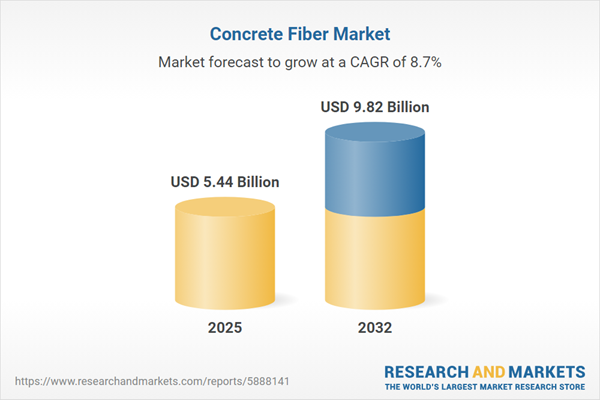Speak directly to the analyst to clarify any post sales queries you may have.
The concrete fiber market is evolving rapidly, driven by growing demands for enhanced durability, sustainability, and compliance within global construction sectors. Advances in material science, strengthened regulations, and shifting supply chains are reshaping opportunities for the industry’s leading stakeholders.
Concrete Fiber Market Snapshot
The Concrete Fiber Market grew from USD 5.03 billion in 2024 to USD 5.44 billion in 2025 and is expected to grow at a CAGR of 8.71%, reaching USD 9.82 billion by 2032.
Growth is propelled by the integration of advanced fiber technologies into next-generation infrastructure and building projects. This momentum is further supported by stricter environmental guidelines and the need to address lifecycle performance in diverse construction settings.
Scope & Segmentation
This report delivers an in-depth analysis of the global concrete fiber market, outlining competitive dynamics, market developments, and emerging trends across multiple segments and regions.
- Fiber Types: Carbon fiber, glass fiber, natural fiber, steel fiber, nylon, polyester, polypropylene.
- Fiber Length: Macro fiber, micro fiber.
- Applications: Flooring, pavement, precast concrete, shotcrete.
- End Use: Commercial, industrial (manufacturing facility, warehouse floors), infrastructure (bridges & tunnels, ports & airports, roads & pavements), mining & tunneling, residential.
- Distribution Channel: Offline, online.
- Regions: Americas (North America: United States, Canada, Mexico; Latin America: Brazil, Argentina, Chile, Colombia, Peru), Europe, Middle East & Africa (United Kingdom, Germany, France, Russia, Italy, Spain, Netherlands, Sweden, Poland, Switzerland, United Arab Emirates, Saudi Arabia, Qatar, Turkey, Israel, South Africa, Nigeria, Egypt, Kenya), Asia-Pacific (China, India, Japan, Australia, South Korea, Indonesia, Thailand, Malaysia, Singapore, Taiwan).
- Notable Companies: ABC Polymer Industries, BASF SE, Bautech, Bekaert SA, BILSTEIN, CEMEX, Danish Fibres, Edil Beton Perugia, Fabpro Polymers, Fibercon International, Flexofibers Europa, FORTA, GCP Applied Technologies, Heidelberg Materials, KrampeHarex, Luoyang Hongfeng Abrasives, Nycon, Owens Corning, Primekss, Si-Tech, Sika AG, The Euclid Chemical Company.
Key Takeaways for Senior Decision-Makers
- The adoption of fiber-reinforced concrete is accelerating in response to regulatory demands and client expectations for sustainability, durability, and enhanced performance.
- Innovative material formulations—such as high-strength carbon fiber and bio-derived alternatives—are enabling tailored solutions for demanding applications and supporting reduced environmental impact.
- Cross-disciplinary partnerships, including collaboration between fiber suppliers, digital platform integrators, and construction firms, are enabling rapid validation and compliance with performance-based standards.
- Emerging markets are leveraging local material advantages, such as natural fibers for residential use and synthetic fibers for mass transit expansion.
- Customized distribution strategies, blending traditional supplier networks with online specialty channels, help mitigate supply chain risk and support project-specific delivery requirements.
Tariff Impact: Navigating New Regulatory Pressures
Recent tariff policies on imported fibers have altered supply chain dynamics, prompting North American contractors and manufacturers to secure long-term domestic supply agreements and diversify sourcing. Strategic partnerships now foster technology transfer and production localization, which together enable resilience amid cost shifts and import uncertainties. Distributors have increased local inventory of synthetic fibers, and research efforts focus on validating the performance of alternatives not affected by these tariffs.
Methodology & Data Sources
The report employs a combination of primary interviews with engineers, developers, and procurement experts, alongside comprehensive secondary research from industry publications, technical papers, and regulatory documentation. Analytical validation ensures objective, actionable insights.
Why This Report Matters
- Uncovers actionable market intelligence for investment, procurement, and partnership strategies across the concrete fiber value chain.
- Offers granular insight into technology trends, regional drivers, and competitive dynamics essential for effective long-term planning.
- Equips executives with segment-level data to optimize fiber selection and deployment for both current and emerging applications.
Conclusion
As construction shifts toward resilience and sustainability, the concrete fiber market offers strategic options that align with regulatory mandates and infrastructure demands. This report provides the depth and clarity required for senior leaders to make informed, future-ready decisions in the evolving concrete fiber landscape.
Additional Product Information:
- Purchase of this report includes 1 year online access with quarterly updates.
- This report can be updated on request. Please contact our Customer Experience team using the Ask a Question widget on our website.
Table of Contents
3. Executive Summary
4. Market Overview
7. Cumulative Impact of Artificial Intelligence 2025
Companies Mentioned
The companies profiled in this Concrete Fiber market report include:- ABC Polymer Industries, LLC
- BASF SE
- Bautech Sp. z o.o.
- Bekaert SA
- BILSTEIN GmbH & Co. KG
- CEMEX S.A.B. de C.V.
- Danish Fibres
- Edil Beton Perugia S.p.A.
- Fabpro Polymers, LLC
- Fibercon International Inc.
- Flexofibers Europa, S.L.
- FORTA Corporation
- GCP Applied Technologies Inc.
- Heidelberg Materials
- KrampeHarex GmbH & Co. KG
- Luoyang Hongfeng Abrasives Co., Ltd.
- Nycon Corporation
- Owens Corning
- Primekss
- Si-Tech Sp. z o.o.
- Sika AG
- The Euclid Chemical Company
Table Information
| Report Attribute | Details |
|---|---|
| No. of Pages | 186 |
| Published | November 2025 |
| Forecast Period | 2025 - 2032 |
| Estimated Market Value ( USD | $ 5.44 Billion |
| Forecasted Market Value ( USD | $ 9.82 Billion |
| Compound Annual Growth Rate | 8.7% |
| Regions Covered | Global |
| No. of Companies Mentioned | 23 |









